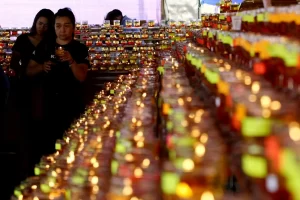An article on how the Wesak Holiday came about in Malaysia, by Achariya S. Vijaya Samarawickrama
On 15 May 2022, Buddhists will celebrate the anniversary of the Buddha’s Enlightenment over 2,600 years ago on the full-moon of the Wesak month, commonly referred to as ‘Wesak Day’. This marks the beginning of the Buddhist Era (B.E.) 2566, calculated from the time of the passing away of the Buddha in 543 BCE. This would make it one of humanity’s oldest religious celebrations, with historical evidence to show that it was first celebrated in Sri Lanka during the reign of King Dutugemunu in 1st century BCE . It is an amazing fact that Wesak was celebrated continuously over the next two thousand years and became so deeply engrained in the Singhalese that they took it with them wherever they travelled in the world.
In Malaysia there is evidence to show that Wesak was celebrated in Penang by the Singhalese community in the last decade of the 18th century. It certainly attracted the attention of the Chinese, Burmese and Thai Buddhists who lived in Penang at that time and over the years, the observance had spread to other towns like Taiping, Kuala Lumpur and Melaka. The celebrations were very much based on the Sri Lankan practice – conducting prayers, learning Dhamma, observing the Eight Precepts, and organising float processions as ways to express our highest reverence and gratitude to the Buddha, Dhamma and Sangha. Many honoured the Three Jewels by not just intensifying their practice, but also to make Buddha-Dhamma known to more people by organising large-scale chanting, Dhamma programmes and teachings, meditation retreats and publishing Dhamma books.
Another unifying aspect of the celebration was the hoisting of the Buddhist flag. This flag was designed by an American Buddhist, Colonel Henry Steel Olcott and raised for the first time on 28 April, 1885. In that particular year, Wesak Day was significant because it marked the first time that the full-moon day of the Wesak month was declared as a public holiday in Sri Lanka by the British Colonial government.
After the First World War, Wesak was so enthusiastically celebrated by the Malaysian Theravada and Mahayana Buddhists, that the Chief Monk of Mahindarama Temple in Penang, Venerable K. Pemaratana, mooted the idea of securing Wesak Day as a public holiday, arguing that it qualified as a national event because roughly about 20% of the country’s population were Buddhists. However, there were many hurdles to be overcome before this dream could become reality.

Offering of lights in memory of the dearly departed is also a common practice during Wesak.
The first hurdle was, that while Theravadins celebrated the occasion of the Buddha’s Birth, Enlightenment and Death in the Wesak month, the Mahayanists observed the day of the Buddha’s Birth on the 8th day of the fourth moon. Since only one day could be recognized, both groups settled the matter amicably at a public meeting in Penang on 1 March 1949 and agreed to accept and propose the full-moon day of the Wesak month as a public holiday so that Buddhists may devote time and effort to observe this day in a meaningful way. A special committee presented a fresh appeal to the government on 25 March 1949.
Partial success was achieved with this public holiday being granted in 1949 in the Straits Settlement of Penang and Malacca, and also in Kedah and Perak where there was a sizeable population of Thais. Employees of the Buddhist faith in Selangor, Kelantan, Trengganu, and Negri Sembilan were allowed to take a holiday. But Buddhists saw that the Wesak observance united all Buddhists, whether they were from the traditions of Mahayana or Theravada, or from lineages of the Chinese, Thai, Burmese, or Singhalese. Spearheaded by the Malayan Buddhist Association (founded 1959), various organisations appealed to the then Home Minister to declare Wesak Day as a National Holiday. The government graciously agreed and on 3 January 1962 declared Wesak Day a Federal Public Holiday from that year onwards. This year marks the 60th anniversary of that historical event.
Today, all of us in Malaysia enjoy the fruits of our forefathers’ labour which allows us to have a full-day holiday to observance this holy anniversary. As we recollect their forward looking and far-reaching efforts, let us show our gratitude by commemorating this auspicious occasion meaningfully as they had envisioned. As Buddhists, let us spend the day spiritually to honour the Buddha, the Fully Enlightened One and reflect on His profound Teachings. Some of the activities which may be useful for you to participate in are Dhamma-learning programmes, meditating for longer periods, reading a Dhamma book or serving the community at temples and Buddhist organisations. May you have a fruitful celebration of Wesak Day. May Buddhism grow and flourish for the welfare and benefit of many. Sukhihontu.
 Holistic Education for Integral Human Development
Holistic Education for Integral Human Development